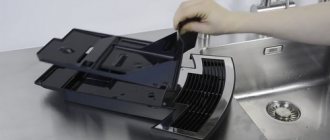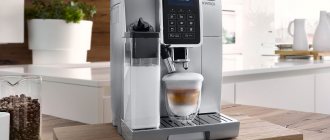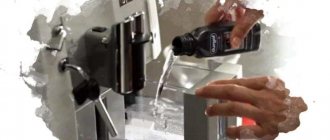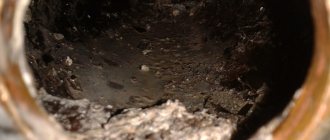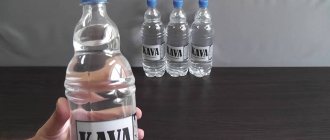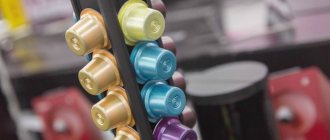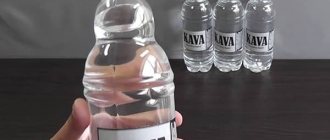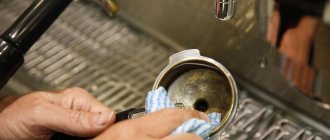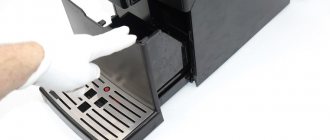Approximately 90% of coffee is water. If your coffee maker brews mediocre coffee, one of the reasons may be the quality of the water.
Scientifically, water hardness is measured by the amount of carbonates in the water. Too much coffee may taste sour. Too little and the coffee can become sour and tasteless. Filtered or distilled water is preferred for making coffee.
If your coffee machine uses not only purified water, but also other forms of water (e.g. filtered, tap, mineral, bottled), there is a high chance that the coffee machine needs cleaning.
This is due to the buildup of minerals such as calcium and magnesium that accumulate on the surface of the machine's heating element.
How scale appears
When water is heated, mineral salts form a precipitate before the boiling process. The sediment forms scale, accumulating on the elements of the coffee machine, accelerating wear and tear of the machine. The limestone layer thickens and compacts over time. The intensity of sediment accumulation is directly proportional to the salt concentration. Therefore, descaling the coffee machine should be done more often, the higher the water hardness.
Water with a lot of dissolved salts is called “hard water.” For coffee machines that heat water, soft water is more suitable. However, according to some studies, protective salt coatings form in the pipes, which is absent with soft water. This, on the other hand, proves that it is not 100% useful.
Water with a salt content of 3 mg/liter is considered soft water, over 12 is considered very hard. We usually use water of medium hardness, where the salt content ranges from 3 to 9 mg per liter. Natural springs contain hard water and are therefore not suitable for coffee machines.
WATER HARDNESS TABLE
By definition, descaling is the process of cleaning metal, removing limescale deposits; a hard, off-white, chalky coating that can interfere with the operation of various components.
Water contains bicarbonates, which decompose when heated above 40 degrees Celsius.
The following reactions occur:
Mg(HCO3)2=MgCO3+H2O+CO2
Ca(HCO3)2=CaCO3+H2O+CO2
Limescale clogs the passage of water through the coffee machine pipes. The smaller the diameter and the greater the bend of the pipes, the more scale forms.
Capsule and carob coffee makers with a boiler heater are more susceptible to clogging with scale than those with a thermoblock. In heaters with a thermoblock, scale forms more slowly, since the water does not stagnate.
How to descale with soda water
- Suitable for any teapots, coffee machines, irons.
- Proportions : the vessels are filled approximately ¾.
- Plus : effective even with thick plaque.
- Disadvantage : a colored drink may stain the vessel. Therefore, to clean irons and white plastic electric kettles, it is better to use clear soda, including mineral water.
How to descale a kettle or coffee machine
Open the bottle and wait until most of the carbon dioxide has evaporated.
Pour the soda into the kettle or coffee maker reservoir, hold for 15–20 minutes, and then boil.
Thanks to phosphoric acid and carbon dioxide, sodas do an excellent job of removing salt deposits.
How to descale your iron
Pour the soda into the water reservoir, turn on the appliance, hold the iron vertically and release steam. If there is a lot of scale, do this several times.
What if you don't descale?
Although calcium and limescale are non-toxic, they can affect the quality of the coffee.
First, a layer of scale can insulate the water and heat source. If the water cannot reach the most favorable brewing temperature, extracting the full flavor from the coffee beans will be futile. In addition, the coffee will not be hot enough.
As soon as the heating output of the boiler decreases, the machine is forced to work harder, which leads to an increase in electricity consumption. A malfunctioning machine will start to rattle and the brewing time will increase as limescale build-up can cause the water flow to be disrupted.
These heating, clogging, and reduced aroma issues degrade the quality of the coffee and can ultimately cause machine failure.
Automatic and semi-automatic coffee machines have a cleaning alert indicator. In production, the coffee machine is set to the highest level of hardness, according to which the number of cups of coffee is calculated, after preparing which it is necessary to decalcify the device (usually about 230-250 cups of coffee). There are no sensors yet that measure and indicate the level of scale formed.
If you ignore the signal about the need for cleaning, the coffee machine may be blocked. But some devices continue to work, giving from time to time a signal about the need for a decalcification process.
How to increase the interval between cleanings
In order to resort to cleaning the device less often, you should remember some rules for its operation:
- Fill the tank with filtered water. In some models it is built-in, however, this does not mean that the quality of water can be neglected. It is worth purchasing a filter in the form of a jug or installing a system on the kitchen faucet. To make life easier, you can purchase bottled water, it does not form scale. This simple technique will allow you to resort to cleaning the coffee machine approximately once every six months.
- Use quality coffee.
- If the device signals the need for cleaning with an indicator of the corresponding color, it is not advisable to ignore it - you just need to start the process with ordinary water, without adding special products.
- The cappuccino maker and coffee compartment should be washed regularly, since the organic environment is a breeding ground for bacteria.
When purchasing kitchen appliances, everyone hopes for its long service life. In order for your coffee machine to delight you with the pleasant taste of your favorite drink, it should be looked after on a regular basis. After all, scale on the boiler, stagnation of milk residues in the cappuccino maker, clogging of the coffee compartment - all this not only affects the quality of the coffee, but sooner or later will cause the unit to break down.
It will be interesting to learn 7 recipes for making coffee in a coffee machine and read the rating of bean coffee brands for coffee machines.
With proper care of your coffee machine, it will constantly delight you with a tasty, aromatic drink.
How to set the water hardness on your coffee machine
The user must adjust the hardness of the water used on the coffee machine. Usually the kit includes special test strips to determine the degree of water hardness. The water quality test is performed in this way: a test strip is immersed in the water used for making coffee, wait about one minute and count the number of squares that have changed color.
1 square – soft water, 2 squares – closer to soft, 3 – closer to hard, 4 – the hardest.
The results obtained will become the basis for setting up the coffee machine for the decalcification process. The service life before cleaning will be maximum for soft water; the period for cleaning the device will come faster for hard water.
How to recognize the need for a procedure?
Usually, you don’t have to wonder if your coffee machine is contaminated with scale and coffee oils. The device lights up. Can appear:
- Loud sounds when brewing coffee. If there is a large amount of contaminants, it is more difficult for the pump to move water, and it begins to operate noisier.
- Stale taste of the drink. Scale and coffee oils deposited on parts greatly degrade the taste of coffee.
- Reducing pressure. If the coffee machine is very dirty, nothing but steam will enter the cup.
- Whitish sediment in the cup. Represents scale particles. Drinking them is not only unpleasant, but also harmful to health.
- Poor performance of the cappuccino maker. A dirty coffee machine is not capable of brewing cappuccino with fluffy foam. The foam will take a long time to whip up, and the output will be large, completely unappetizing bubbles.
How often should you clean your coffee machine?
When using a proprietary filter built into the coffee machine, the device can consider the water ideal and does not require long-term decalcification. But the coffee machine needs to be cleaned at least once a year, even when using reverse osmosis purity water. Reverse osmosis and bottled water do not form scale. To ensure that the device does not require frequent cleaning, you should specify the use of a proprietary filter in the settings. When you use bottled or reverse osmosis water and the machine still requires cleaning, you need to run a decalcification program with clean water. Only then will the cup counter reset to zero.
If the coffee machine beeps, requiring descaling, the process should not be postponed. There should be decalcifying agents on hand for a couple of cleanings.
How to understand when it's time to clean your coffee machine
It also happens that cleaning is required much earlier than the indicator lights up. In older models there is no such notification at all. Therefore, it is important to independently determine when the boiler needs to be descaled. This is evidenced by such “symptoms” as:
- Unusual taste of coffee (appearance of bitterness, white sediment or pieces of scale, weakening of strength)
- Extraneous noise or rattling noise when the coffee machine is operating
- Longer boiling time for water
- Reduced steam and water supply
The appearance of at least one of these signs is a reason to think about how long ago the device was cleaned. If 3 weeks or more have passed, then you don’t have to wait for a signal and decalcify as soon as possible.
How to descale
Some tips on where to start the cleaning process.
Always read the machine care manual in advance.
The instructions for the coffee machine describe the cleaning process in detail. There is no universal algorithm; each coffee machine model has its own descaling procedure.
Homemade descaler
If the manual for your coffee machine does not mention a specific descaling agent, you can use a solution by preparing it yourself.
Causes of scale
The water contains calcium and magnesium salts. Moreover, minerals are present in both “hard” and “soft” liquids, although in different proportions. When using a coffee maker, salt deposits occur on the elements of the device (especially the heating device, filters) in contact with water, i.e. plaque (or scale) forms.
There are some recommendations that should be followed not only when cleaning the device from deposits, but also when using the coffee machine:
- With prolonged use of the coffee machine and lack of cleaning, plaque accumulates in large volumes. Therefore, to remove scale, it is recommended to first pour the product into the tank and leave for 30-40 minutes. Afterwards, carry out the decalcification procedure according to the instructions.
- To increase the period of time between descaling the device, it is recommended to use only bottled water or use special filters for the liquid.
- After the cleaning procedure, it is not recommended to drink coffee - you need to thoroughly rinse the tank under running water, and simply throw out the drink brewed 2-3 times.
- Do not mix different solutions with each other, incl. chemicals with folk remedies.
- To avoid damage to heating and other parts of the device, it is prohibited to use abrasive substances, incl. not intended for decalcification (washing powders, acids, etc.).
- If there are dismountable parts (horn, pulp container, etc.), they must be removed and the deposits removed with a sponge or brush, having first disconnected the device from the electricity.
- If after cleaning the glass container for the finished coffee becomes cloudy, it is recommended to pour a warm solution into it (for example, 1 tablespoon of baking soda per 200 ml of water), wait 20-30 minutes and rinse the container with clean liquid.
- It is prohibited to use metal objects (knives, etc.) for descaling to avoid damaging parts.
In order for the coffee maker to serve for a long time, it is necessary to follow the manufacturer's recommendations, periodically descale it and not use the device for other purposes.
If in doubt about the choice of decalcification agent, it is better to consult with a specialist (for example, with the seller from whom you purchased the device).
Brand specific descaling agent
Most coffee machine manufacturers sell their own branded descaling products or recommend a specific descaling agent for the machine.
Manufacturers often recommend against using third-party brands or homemade descaling products, especially during the initial warranty period of the machine.
This is because using a recommended descaling product reduces the chance of harmful acids that can cause corrosion to the machine and also void your warranty.
Always ensure that the descaling agent is non-toxic and does not leave any residue. Often, descaling products come in the form of a tablet or liquid solution.
The descaling process is different for each machine. Always follow the instructions provided in the manufacturer's manual. Ideally, repeat this deep cleaning every 3-4 months to prevent nasty deposits from building up and keeping your coffee fresh and rich.
How to clean scale with brine
- Suitable for any teapots.
- Proportions : the kettle must be filled ¾ full.
- Pros : simplicity, accessibility.
- Cons : does not cope with persistent plaque, specific smell.
The brine contains lactic and acetic acids. Fill the kettle with strained cucumber or tomato brine and boil for 20–30 minutes.
After this, drain the brine and scale and wash the kettle with a soft sponge and cleaning agent.
Which cleaning product to choose?
Coffee is a very oily substance by nature. Over time, coffee oils accumulate inside the machine, forming a rancid residue. Cleaning your coffee machine removes residue to keep your coffee fresh.
Expensive models of coffee machines have an indicator indicating when decalcification time has arrived. It does not measure a layer of scale, but a certain number of cups of brewed coffee, after which the machine needs to be cleaned.
Owners of inexpensive coffee machines that do not have such an indicator have to recognize the need for cleaning themselves.
The following signs will let you know it's time to clean your car:
- The espresso machine produces weak, cool coffee with an unpleasant, sour, bitter taste
- coffee takes longer to brew than usual
- At the bottom of the cup after coffee, scale remains in the form of sediment
- The water takes longer to heat up, the coffee flows with difficulty
- The coffee machine is loud and crackling
- electrical energy is consumed more to operate the device
- steam pressure decreases
This means it’s time to give your machine the necessary attention and descale it.
A quick step-by-step video guide to get you started:
Using folk remedies for cleansing
If you don’t want to spend money on expensive products to clean your coffee machine, you can resort to traditional methods of getting rid of scale and sediment. Owners of coffee makers are recommended to use solutions of vinegar or citric acid. Specialists who repair such units insist that for cleaning it is still better to use professional products that will certainly not cause harm to the device.
Vinegar and citric acid are very caustic substances that can damage the surface of the coffee machine, causing it to work much slower or simply break completely. However, if you do everything correctly, this risk will be minimized. Each method is discussed in more detail below.
Cleaners
Coffee maker manufacturers such as Philips Saeco, Bosch, DeLonghi, Jura, Melitta, Krups, etc. offer branded anti-scale products. In fact, all these companies do not produce the products themselves, but rather contract companies. They are called OEMs (companies that copy existing products). One brand's proprietary product is also suitable for another brand.
Universal products can be used in any automatic coffee machine. These are Top House, Urnex, Topperr, Philips-Saeco, Delonghi, Swipl, WPRO, Melitta Anti calc, Bubble Ice, Kumkumit and others.
Of the branded products, Bosch and Melitta brands are the cheapest. The products can be found at hardware stores or hardware stores. When using, do not exceed the proportions indicated in the package.
Tablets, powders, or liquid descalers are all about equally effective, although the price may vary. Before starting the cleaning process, tablets and powders must be completely dissolved. The water tank is filled to the maximum level.
All special products contain acids (maleic, citric and sulfamic), baking soda to remove contaminants and a corrosion inhibitor. They must not include toxic substances. The means are written CALC; descaling; decalcifier and can be recognized by these inscriptions.
- Powdered universal decalcifiers and coffee oil removers. The powder is dissolved in water and poured into a water tank. The proportion is indicated in the instructions. In addition to cleaning, they protect against corrosion.
- Liquid cleaning products are poured into the water container to the fullest. Therefore, their application is simple.
Exceeding the proportions and improper cleaning will cause the coffee machine to fail.
Descaling with liquid products
You can clean the coffee maker yourself. First, carefully read the instructions from him. If you have lost it, try to find it and download it on the Internet. Usually the manufacturer indicates in detail how to properly clean the device. All you have to do is follow his instructions.
In this article we will present the most universal methods for cleaning coffee machines. However, they may vary for specific models.
The liquid cleansing technology is as follows:
1. Remove any remaining coffee from the filter and container.
2. Prepare the cleaning solution according to the instructions and pour it into the water container up to the max.
3. Turn on the coffee machine and open the tap, drain about 150 ml of liquid. Then drain the solution in small portions every 5 minutes.
5. If the device does not have a sprayer, then at the end of the procedure, when the cleaning solution has not yet run out, add coffee and start the drink preparation program. When the coffee is ready, continue draining the cleaner. The drink, of course, needs to be poured out.
For carob-type devices or with a sprayer, it is possible to execute the program without adding coffee.
4. After the cleaning liquid has run out, remove the tank, rinse it under the tap and fill it with clean cold water. Now repeat step 3.
5. Rinse the brewing unit of the device with water.
Cleaning tablets
Tablets are compressed into a tablet, while capsules are encapsulated decalcifiers. Use one capsule or one tablet per cleaning. Comprehensive cleaning of coffee machines includes both decalcification and removal of coffee oils. To remove scale, you need to buy the appropriate tablet, and to remove oil, you need to buy another one. That is, the tablets do not replace each other.
Before starting the decalcification process, the tablet must be completely dissolved in water.
Tip: It is recommended to descale your espresso machine at least once a month to ensure a rich morning coffee every day.
Cleaning the coffee machine with tablets
These tablets are labeled “For decalcification” and are intended to cleanse plaque from internal elements. It is advisable to use a product from the same company as the coffee machine.
Be sure to completely dissolve the tablet in clean water. Pour the resulting liquid into the coffee machine reservoir. Turn on the coffee preparation mode. Turn off the machine as soon as the glass is half full. After 15 minutes, start the device, the rest of the portion will pour into the glass. Clean the brewing unit. Run the cooking program twice, but without the tablet and coffee.
Step-by-step instructions for descaling your coffee machine
You need to choose a descaling agent.
A decalcifier helps extend the life of your coffee machine by reducing the likelihood of premature failure due to scale deposits.
They also have disinfectant and antibacterial properties. This cleaning refers to biodegradable technology. In addition, it slows down corrosion. So you don't have to worry about storing the descaling product for a long period of time.
There is currently a large selection of descaling products on the market for coffee machines from different manufacturers. They produce products in the form of powder, liquid solutions, capsules and tablets. Manufacturers of well-known brands of coffee machines make money by producing products for devices of their brand with certain advantages. They do not recommend using products from other brands. Special descaling agents are expensive and provide better results. If you lack funds, you can choose a cheaper analogue.
Special cleaning products for coffee machines are divided into two types according to their purpose: for decalcification and for removing coffee oils. Descaling agents do not remove oils from the coffee machine. Before using, you need to read their instructions. Operating instructions for each model can be found on the Internet.
Removing scale from a coffee machine.
It's time to descale and remove limescale from your coffee machine.
First of all, check if your coffee machine is programmed for an automatic cleaning and descaling cycle. If yes, then you are lucky. If not, then it just means you'll have to do it manually.
It is recommended that you read the user manual first for specific instructions on how to descale your coffee machine.
Dissolve a special product in the water tank. It passes through the boiler and the machine.
You also need to pass it through a steam wand.
Close the steam knob and turn off the machine.
Next, let the descaling solution sit for 15-20 minutes so that it can work its way through all the small tubes in the machine and clean off any residue.
Then empty the steam wand about half the tank before turning off the machine for another 15-20 minutes.
The last step is to rinse the remaining water in the tank from the steam wand.
Rinse and rinse again.
Product particles may remain inside the machine's pipes, so it is important to rinse them with water after cleaning the machine. This time, fill the tank with water and repeat the steps above.
Although some people perform one rinse cycle, two cycles are recommended to ensure that the solution has been thoroughly removed from the machine.
You need to smell the water coming out of the machine to assess the degree of purification. If the water becomes clear and there are no foreign odors, then the coffee machine is cleaned.
Prepare your espresso.
Now that the scale has been removed, it's time to reward yourself with an espresso. Let the coffee machine prepare you a fresh cup of coffee. There is nothing better than a cup of espresso from a clean coffee machine.
The cornerstone of any care is decalcification.
Decalcification is a process during which the internal filling of the device gets rid of scale. I will add that it is centuries-old calcium deposits that most often become the cause of failure . The operation is carried out in full accordance with the instructions of the manufacturer of your coffee machine. Initially, I advise you to look there to understand how step-by-step cleaning is performed.
Coffee machines with automatic decalcification
The fact is that there is no universal algorithm; you need to know what to put inside and what buttons to press . Some brands complicate the process by forcing the user to perform at least ten different steps. For example, when cleaning manually, it is necessary to pass the solution through the cappuccino maker in portions of 50 ml, observing pauses of 2-5 minutes. If an error occurs, you will have to restart decalcification, so extreme care is required.
I will make a reservation that premium models rarely give multi-step instructions, although there are exceptions.
However, basically cleaning is carried out in 2-3 steps:
- The cleaning agent is loaded into the tank;
- The automatic decalcification mode is activated, for which just pressing one button is enough. It is designated as Decalc, Calc, Decal. Automatic decalcification lasts 25-40 minutes. Once the operation is complete, do not add any liquids to the container until the machine says that cleaning is complete.
The best coffee machines with adjustable water hardness
After manual or automatic descaling, rinsing is always carried out .
To do this, empty all trays and water tank. Clean water is poured into it and a clean water cycle is started using 1-2 full hoppers. After rinsing, clean water is poured in and the tank filter is returned to its place. I recommend pouring the first 2-3 cups of espresso down the sink. Let me add that professional machines connected to the water supply are decalcified only after disassembling the device . In fact, the cleaning procedure is part of the maintenance.
It happens that the instructions are simply lost or it is an office device for which no one is responsible. What can I recommend here? - Internet to help. You should type the model name + “instructions” into the search engine. With a 99% probability, the system will produce the required document with the ability to view and download. Here you can learn all the details of cleaning and care. As an alternative, call a specialist service .
About choosing between a service center and an ad master
But this is not free and, frankly, with all the prevalence of the Internet, it is unreasonable.
How to descale a coffee machine - choose a decalcinator
In addition to the manufacturer's instructions, you should be careful about the choice of cleaning agent. Everything is the same here: preparations intended for decalcification work to remove scale . Coffee machine brands do not hesitate to lobby for their products, but there are no significant differences between them.
Branded powders and tablets are widely produced by the companies Krups, Philips, Saeco, Delonghi, but none of them produces them on their own, leaving this headache to OEM contractors. But almost all funds are sold at a fairly high cost, not less than 1 thousand rubles. per package.
In practice, it is permissible to use any cleaner, including a budget one . You will definitely not be disappointed in the effectiveness if you can comply with all the recommended proportions. There is no need to overpay for a brand. But, make sure that the decalcinator is intended for automatic coffee machines . You can purchase the product in a large chain store like Eldorado.
There may be several options:
- dry powder - poured into a water tank in a dissolved state. Pour the liquid until it reaches the maximum mark of the tank. Each manufacturer recommends using certain proportions, which is easy to read on the packaging;
- tablets are essentially the same powder that has been given the appearance. The active substances are pressed into a fancy shape and dissolve in water in the same way. Dissolution must be complete;
- liquid decalcifiers;
- cleaning capsules – for capsule coffee machines.
Any of the indicated products is diluted in water. The total amount of liquid is taken to be 1-2 liters or more. Before use, remove the cleaning filter from the tank, if there is one . Otherwise, if the solution passes through it, it will be irrevocably damaged.
Among the brands you can note Bosch tablets - you will pay about 750 rubles. for a package of three briquettes, dry and liquid Melitta cleaners, they can be called budget, Philips Saeco products - from 800 rubles / 250 ml of liquid decalcifier. One of the most expensive are Krups powders (the average price for a package of two bags is 800 rubles). Feel free to turn to less expensive options.
What to do with folk recipes
The Internet is full of recipes where it is recommended to use Coca-Cola, vinegar, and citric acid to descale. We immediately discard the drink and essence - the equipment will fail “at once”. Citric acid can be used at a stretch, I would say, in desperate situations, by diluting the powder 10 g in a liter of water. Next, the mixture is poured into the water tank and the instructions are followed.
However, no matter how you look at it, the cleaning will not be complete. All home methods are inferior to professional ones in terms of effectiveness. There are also pitfalls - citric acid has an aggressive chemical effect, and it will gradually corrode rubber seals and aluminum parts if you decide to use this option on an ongoing basis.
As a result, I would recommend turning to professional descalers. Their cost is high compared to the same citric acid, but it is insignificant compared to the cost of repairs.
Frequency of descaling the coffee machine
Every more or less smart device will ask itself to be cleaned by displaying an indication on the screen or case. However, there are several subtle points here, since each coffee machine determines the need for decalcification differently.
The fact is that the presence of scale cannot be determined using sensors or other clever devices. The device indicates the need for cleaning only on the basis of counting the cooked portions . If the device decalcifies after 250 cups, it will give a signal after 250 cups. At the same time, visually the boiler may become overgrown with deposits or remain crystal clear.
What does this depend on? The first is the quality of the water being poured. If it is hard, the heating elements will quickly become covered with deposits, perhaps much before the machine displays the cleaning indication. The user is faced with the task of correlating the amount of water with the number of servings and the rate of scale formation.
About the necessary water treatment for a coffee machine
The water hardness programming option will help you. A special test strip is often included with the coffee machine . It is enough to add water and determine its actual hardness, after which the settings are set based on it. Thanks to this simple programming (all details are always described in the instructions for the device), the machine will begin to count the number of cups based on the set hardness of the water that flows from your tap.
Instructions for measuring water hardness:
- pour water into a glass;
- We immerse the tester in it (a couple of seconds is enough). One strip is for one test;
- wait a minute;
- check how many divisions have changed color;
- a typical decoding is as follows: 1 division - very soft water, 2 - soft, 3 - hard, 4 - very hard;
- go to the menu, find the hardness settings and select the value corresponding to the obtained one.
I would like to draw your attention to the fact that the factory settings are mainly aimed at maximum rigidity . This does not always work - if soft water flows from the tap, the machine will require decalcification more often than it needs. Conversely, there are devices with average factory settings - when the water is hard, all heating elements will suffer. That’s why it’s so important to set the correct value yourself.
If the machine issues a cleaning request, this point cannot be ignored. There are models that will automatically lock if the user has not decalcified . There are those that work for several weeks, despite the indication, but this threatens to break, despite such “tolerance”. In general, it is better to be prudent and purchase products in reserve - for a couple of cleanings.
Prevention is everything
To ensure that the need for decalcification occurs as rarely as possible, you should carefully consider the quality of the water used. The liquid must be soft and clean . Then the machine is programmed for minimal hardness and requires cleaning to be started extremely rarely.
Preventative care for your coffee machine
This is achieved in two ways:
- filtration;
- filling with bottled water. I’ll say right away that this is a more effective option, but less convenient.
Filtration can be double. The first filter is installed in the coffee machine itself. The second is either at the water tap (household purification systems using so-called reverse osmosis) or in an Aquaphor-type jug.
The best coffee makers with a permanent filter
Please note that a device with a filter installed in the tank may not require decalcification at all, since these may be the factory settings.
He just thinks the water is perfect. If you use osmotic filtration, scale will actually not form .
However, deposit removal is carried out at least once a year, even without the requirement of a coffee machine. What to do if the water filter fails
Cleaning the coffee machine brewing unit
The brewing unit is the main part of the coffee machine. This block becomes contaminated over time with particles of ground powder and coffee oils.
Coffee machines have a built-in or removable brewing unit.
The removable brewing unit should be removed and washed once every month under tap water. Place the dried block back into the coffee machine. In addition, it is recommended to clean the brewing unit and pipes of the coffee machine from oils every 200-300 cups using special means.
Devices with non-removable units should be cleaned with special products immediately upon signal from the coffee machine. Refusal to clean or delay may cause the device to break down.
Coffee oil cleaning tablets are also called coffee system cleaners. Manufacturers strongly advise using only “branded” products. In fact, they are all the same. However, “off-brand” oil remedies are almost impossible to find. Of the originals, Bosch and Melitta are the cheapest. Among the “non-original” tablets, the most affordable ones are Topper and Cafiza.
The cleaning process is described in detail in the instructions. But Delonghi, for example, in its manuals says nothing about the need to remove oils.
The cleaning process is as follows:
- In the model, find a block for ground coffee and a program for brewing coffee from ground coffee.
- Start the “Ground coffee” preparation mode
- Pour a tablet of the product into the block for ground coffee, dissolving it in water
- Place the container and start brewing large volume coffee
- Pour out the water
- Without ground coffee, repeat two espresso preparations of maximum volume
- Pour out the water
What else needs to be done
Firstly, a simple wipe of the case from dirt and dust won’t hurt. You cannot ignore such a detail as the water collection pan - periodic drainage of the liquid is required . Otherwise, a hint of mold and a musty smell may appear. By the way, once a month you can wash this thing in the dishwasher using a temperature no higher than 60 degrees. The tray should be thoroughly cleaned before reinstallation.
Cleaning the pulp compartment
The second unit that everyone forgets about is a container for collecting waste cake . Waste should be taken out strictly with the coffee machine turned on. This way all the meters will react correctly and the device will work in its own way. Otherwise, the signal for cleaning will come when the pulp no longer fits into the compartment. This causes jamming and contamination of the infuser and internal filling.
Cleaning the coffee grinder
The quality of espresso in a cup depends not only on the cleanliness of the entire coffee-milk tract and the brewer. The condition of the coffee grinder plays a significant role. After grinding, particles of ground powder settle between the teeth of the millstones. The deposits consist of oils and fats; under the influence of high temperatures they stick together, significantly distorting the taste of the drink, forming mold.
The best coffee machines with bean grinding settings
Millstone cleaning is carried out using two products - special powder or tablets . Powder is a finely crystalline substance based on food starch. The bottom line is that it is able to effectively absorb fats and oils. Cleaning frequency: every 3-4 kg of coffee .
All types of millstones are cleaned according to the same principle:
- the bean hopper is cleared of coffee;
- activate the grinding to completely remove the remaining grains;
- a bag of powder or tablet is added to the hopper. The composition must pass through the millstones;
- turn on the grinding for 5-6 s;
- the container is filled with grains;
- Pour the first 2-3 servings of the finished drink into the sink.
Another important point is regular lubrication of the moving parts of the removable infuser. Every device needs this. Average frequency: every 500 cups . What and how to lubricate is described in detail in the instructions for each specific model (seals, cuffs, etc.).
Particularly generous brands include a tube with a special product in the kit. These are silicone lubricants with the first food grade approval (NSF H1). They can be purchased at any large electrical goods store. If you neglect maintenance, the teapot will jam and possibly fail altogether.
Cleaning the cappuccino maker of automatic coffee machines
Dairy machines with automatic cappuccino makers come with a built-in jug and a discharge tube. Cleaning cappuccino makers is very important. Dried milk is a favorable environment for the proliferation of bacteria, mold growth, and milk can also clog tubes. The milk frother must be cleaned regularly after each use with a special product. Cleaning is carried out in disassembled form. If you do not clean it, the milk tube may become clogged and will not produce foam well.
Each manufacturer produces its own product. Unbranded analogues are also present.
At home, you can prepare a substitute for cleaning products. To do this, you need to dilute one tablespoon of baking soda in a liter of warm water. Pour the prepared soda solution into a bowl, disassemble the cappuccino maker, soak it in the solution for a couple of hours, then rinse with water. The automatic milk frother can also be washed in the dishwasher.
Cleaning algorithm:
- Place water instead of milk and turn on the cappuccino mode. Continue cleaning until the water becomes clear.
- Rinse the jug under running water or in the dishwasher.
- Special liquid or tablet products for dairy systems will be useful.
What causes a coffee machine to become dirty?
The coffee machine gets dirty faster and more heavily than any other appliance in the kitchen. It not only heats water, but also drives coffee and milk through it. Like any other device, it becomes covered with dirt and dust. You have to deal with the following types of pollution:
- External – dust, fingerprints and kitchen grease.
- Internal – scale, film from coffee oils and milk. As a result of heating, contaminants turn into solid deposits.
It is the oil in the coffee beans that creates that magnificent foam on the surface of the espresso. The other side of the coin is that with each portion of coffee prepared, the sieve inside the machine becomes clogged with oils.
Automatic cleaning of the coffee machine
In modern coffee machines, scale and remaining coffee oils can be removed using the auto-cleaning mode. This function is available in more expensive models of coffee machines.
You need to follow the following instructions:
- Clean the coffee stand and grinder;
- Fill the tank with hot water to the highest mark;
- Pour in the prepared cleaning solution;
- Enable auto cleanup feature. The smart machine will do everything itself. All that remains is to add the cleaning solution or water and follow the commands that appear on the device’s control panel. Typically cleaning lasts about 5 minutes.
- After turning off, rinse the tank and fill it with clean water;
- Start the coffee brewing mode with clean water several times in the usual way;
- Pour out the finished coffee to remove any remaining cleaning agent.
Basic rules for caring for a coffee machine
After choosing a suitable decalcinator, the problem of “how to clean a coffee machine” ceases to be so difficult.
If you want to clean the device without any problems, follow the following sequence:
- Carefully check whether there are any coffee residues in the coffee machine, throw away the used capsules and cake from the waste container.
- You need to pour about a liter of warm (not hot!) water into the reservoir.
- Add the required amount of decalcifier to the water. The instructions for the substance always indicate how much it needs to be taken to descale it.
- Then you can turn on the car.
- Next, place a deep container where the bowl is usually located, open the tap, and drain about half a glass of the resulting solution.
- Unplug the coffee machine, leave it for a short period of time and turn it on again; there is no need to close the tap yet.
You will have to do this procedure (turn it on and off) several times; using this scheme you can clean the hydraulic system.
If you want to clean the part of the device in which the drink is prepared, then you need to prepare 2-3 cups of a solution with a decalcifier, like regular coffee.
If you are the owner of a carob coffee machine, or a device in which you can brew ground coffee, then you don’t have to add ground beans. In all other cases this must be done. After finishing the cleaning process, rinse the device again with clean running water and turn on the cappuccino maker to clean it too. After the final rinse, the machine is ready for use again!
Advice:
Tips for care and prevention of scale
A coffee machine, like any equipment, needs care and in order for it to serve for a long time, you need to take care of it and follow some rules:
- The coffee maker must be cleaned of dry coffee residues every time after use.
- When brewing coffee, try to use purified water to prevent scale.
- Use high quality coffee beans or ground coffee from trusted brands to avoid clogging the machine
- Completely clean the device once a month.
- Before purchasing a cleaning product, you should read the instruction manual. Cleaning products from the same brand are preferable.
- Chasing cheapness, excessive passion for folk remedies can cause you to break down your coffee machine
- The cappuccino maker should be cleaned after each drink preparation process. After each use, run liquid through it and wipe the spout.
- Clean coffee oils using folk or specialized means
- Do not leave water or milk in containers for long periods of time.
- Change filters in a timely manner
- Thoroughly clean disassembled parts every three months
- If there are no water filters in the house, use only bottled water with a salt content of 75 to 250 g/l to brew the drink.
- There is no need to mix solutions of branded products with citric or acetic acid
- Do not use abrasive products to descale the coffee maker.
- Several servings of coffee brewed immediately after cleaning cannot be drunk; they will have to be thrown away.
Post Views: 2,877
Manual method of cleaning and rinsing with citric acid
If there is no self-cleaning function, then you will have to remove the scale manually. However, it also takes very little time and does not require much effort, because you don’t have to rub anything. You need to dilute the decalcifier in clean hot water and pour the mixture into the water tank. Turn on the coffee brewing mode and repeat it several times. Then remove the water with the product and add filtered water, run 3-4 cycles of preparing drinks. Next, you should add coffee and prepare it as usual, but pour out the first two cups. The coffee machine is now completely cleaned and all traces of chemicals have been removed.
If there is no warning in the instructions, then the device can be cleaned with citric acid; it perfectly destroys the plaque formed on the boiler. This method will take much more time, but will help if you don’t have any special tools at hand.
Dissolve 15 g of citric acid in 500 ml of water and pour the solution into the tank. In espresso mode, run the coffee machine for two cycles. Leave the water with acid in the apparatus for 3-4 hours, then drain it. Rinse the device several times with filtered water. Since citric acid is more natural than chemical decalcifiers, after rinsing, you can immediately start brewing coffee.
Cleaning procedure
After reading the instruction manual, you can choose the available method for removing limestone.
Cleaning methods
Depending on the design features, you can choose one of two cleaning options: automatic or manual. Expensive, technically complex models are equipped with an automatic descaling system. In this case, the procedure might look like this:
- Instructions for Bosch coffee machines
- the product recommended by the manufacturer is loaded into the device;
- pressing the button starts the automatic program;
- after that all that remains is to wait for its completion.
Manual cleaning is a little more difficult: a product diluted in the required proportions is gradually passed through the system. After about half an hour, the car should be rinsed generously with cold water.
Special means
You can descale your Bosch coffee machine at home using special products. Such drugs are available in liquid or tablet form.
- Top House, a German-made cleaner designed specifically for coffee machines, including Bosch. The liquid formula allows you to completely get rid of scale in one application.
- Topperr, another German liquid for effectively removing stone from coffee makers. Similar to the previous one, it was made taking into account the recommendations of the largest coffee machine manufacturers.
- Bosch TCZ 8002, special tablets for coffee machines, can be used in capsule-type devices. In addition to removing stone, they protect against oxide and corrosion.
Usually the manufacturer recommends using original products. However, experts consider such conditions to be purely a marketing ploy and allow the use of products from different manufacturers.
Popular folk remedies
It is also not recommended to use folk remedies prepared at home. But user experience shows that some available drugs are harmless when used correctly. These include citric acid. In this case, 10 grams of acid are dissolved in a liter of water and poured into a container. Further actions are similar to using factory cleaners. It is strictly unacceptable to clean the coffee machine with vinegar, soda, and especially Coke. In general, comparisons of the effectiveness of manufactured and traditional drugs are not in favor of the latter. The savings from their use are small, and the efficiency is worse.
Instructions for BOSCH coffee makers
| Instructions for coffee maker Bosch TAS40/42 XXEE |
| Instructions for coffee maker Bosch TAS-2005 EE |
| Instructions for coffee maker Bosch TAS6515 EE |
| Instructions for coffee maker Bosch TCA4101 |
Among coffee fans, coffee makers and coffee machines from Bosch are very popular, the quality of which has been tested by time. Reliability, durability, simplicity and ease of use are the calling cards of this manufacturer. With proper maintenance, breakdowns and, accordingly, repairs of a Bosch coffee machine are practically impossible throughout the entire service life of the unit.
In order for the machine to delight you with freshly prepared coffee for a long time, it is necessary to regularly clean it from scale and deposits of coffee oil that gradually form on the working surfaces of the coffee machine.
Cleaning the coffee machine with decalcifiers
Decalcifiers contain inorganic acids and corrosion inhibitors. They effectively dissolve solid deposits and are at the same time safe for coffee machine parts. Decalcification preparations come in liquid (concentrated or ready-to-use) and powder form. Powders are usually dissolved in 1 liter of water and the hopper is filled.
Cleaning the coffee machine with decalcifiers lasts from 20 minutes. The general principle is:
- Filling the water tank with descaling solution.
- Selecting the desired program(s).
- Cleaning. During cleaning, the solution comes out in small doses.
- Rinsing the hopper and the insides of the apparatus with 2-3 liters of clean water.
Decalcifier for Saeco coffee machines
Saeco Decalcifier is a liquid concentrate with a volume of 250 ml. To clean the coffee machine from scale, you need to pour it into an empty hopper and add 1 warm water (50-60 degrees). After this, pass 2-3 cups of water through the tube and turn off the device from the network. Wait 5 minutes and skip a few cups again.
We recommend: How to check the authenticity of a diamond: 5 tests that a real stone will pass
This is repeated until the tank is empty. Then the hopper is washed, filled with fresh water, and all of it is passed through the system (the coffee machine is rinsed of any residual cleaner).
Descaling agent SVOD-TVN
The preparation for coffee machines SVOD-TVN is available in powder form. To clean the device from scale, you need to dissolve 1-2.5 measuring spoons (20-50 g) in 1 liter of warm water and fill the hopper. Prepare several cups of the drink, wait 5-10 minutes. Repeat the operation. Wash the hopper and run 2-3 liters of fresh water through the coffee machine.
Delonghi ECODECALK descaling agent
Liquid preparation. A 500 ml bottle is enough to descale your coffee machine 5 times. The product is best suited for Delonghi brand coffee machines, but can also be used for machines from other companies. Pour 100 ml of liquid into the hopper and add 1 liter of warm water. Cleaning is carried out in the standard way.
We clean with what we have at hand at home
Vinegar 9%
First, let's talk about how to clean a coffee maker with 9% vinegar. It contains alcohols, esters, food acids: malic, citric, which effectively dissolve scale.
Mix vinegar and water in a 1:2 ratio. Pour liquid into the water container and turn on the device. Wait for the water to boil and leave the coffee maker for 10-12 hours.
Interesting! What to brew coffee in: review of utensils
Then pour out the cleaning solution and rinse the device with warm water.
The next stage is running the liquid. Prepare 4-5 cups of coffee. Don't drink it - throw it away, otherwise you'll get poisoned.
If you don't rinse off the water, vinegar residue will settle on the parts. The drink will acquire an unpleasant taste and sour smell.
Have you tried using vinegar?
Not really
Lemon acid
Now about how to clean a coffee maker with citric acid. Pour 2 tbsp into a liter of water. l. facilities. The remaining steps are similar to the previous method.
Turn off the device when the water boils and leave for 2-3 hours.
Rinse the device parts under water. Pour clean water into the tank and boil it three times.
Then brew 3-4 cups of coffee to help draw out the liquid.
Lemon can deal with fresh limescale. Cut it into circles, put it in a tank and fill it with water. Boil the liquid and leave for half an hour.
Soda and salt
Dilute 2 tbsp. l. soda-salt mixture in 0.5 liters of warm water. Pour the solution into the tank and leave for 5 hours. There is no need to turn on the device.
Alkali reacts with limescale and destroys it.
Pour out the solution and rinse the device.
Coca Cola
To descale your coffee maker, use Coca-Cola. The drink contains phosphoric acid, which breaks down sediment.
Soda will not cope with a thick layer of plaque, but it will clean light stains.
Fill the reservoir to the brim with cola, turn on the device and boil the liquid.
Cleaning time – 2-3 hours.
Pour out the soda, rinse the device and wipe dry.
Denture cleaning tablets
The product contains detergents, oxidizing agents and active oxygen. The tablets will cope with weak plaque and disinfect the device.
It is not recommended to regularly clean the device in this way - the tablets will not provide proper care.
Brew coffee with bottled or filtered water. The device will have to be cleaned less often.
